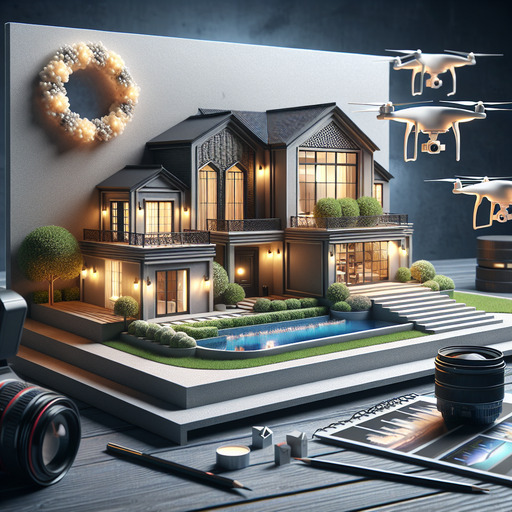
-
Table of Contents
- Mastering Real Estate Photography: Tips, Techniques, and Tools
- Understanding the Importance of Real Estate Photography
- The Impact of Quality Photos on Property Sales
- Essential Real Estate Photography Tips
- 1. Use the Right Equipment
- 2. Master Real Estate Photography Lighting
- 3. Perfect Your Composition
- Advanced Techniques: Real Estate Drone Photography
- Enhancing Your Photos: Real Estate Photography Editing
- Pricing Your Real Estate Photography Services
- Conclusion
- Questions and Answers
- 1. What is the best time of day for real estate photography?
- 2. How can I improve my real estate photography composition?
- 3. What are the benefits of using drones in real estate photography?
Mastering Real Estate Photography: Tips, Techniques, and Tools
In the competitive world of real estate, first impressions are everything. High-quality real estate photography can make or break a property listing, influencing potential buyers’ decisions before they even step foot inside. This guide will explore essential tips, techniques, and tools to elevate your real estate photography game, ensuring your listings stand out in the crowded market.
Understanding the Importance of Real Estate Photography
Real estate photography is more than just snapping pictures of a property. It’s about capturing the essence and potential of a space, enticing buyers to envision themselves living there. According to the National Association of Realtors, 87% of home buyers found photos to be the most useful feature when searching for a home online.
The Impact of Quality Photos on Property Sales
- Properties with high-quality images sell 32% faster than those with lower-quality visuals.
- Listings with professional photos receive 118% more online views.
- Homes priced between $200,000 and $1 million sell for $3,000 to $11,000 more when they feature professional photography.
Essential Real Estate Photography Tips
To capture stunning real estate photos, consider these practical tips:
1. Use the Right Equipment
Investing in the right real estate photography equipment is crucial. A DSLR camera with a wide-angle lens is ideal for capturing spacious interiors. Additionally, a sturdy tripod ensures stability and sharp images.
2. Master Real Estate Photography Lighting
Lighting can make or break a photo. Utilize natural light by shooting during the golden hours—early morning or late afternoon. For interiors, consider using external flashes or softboxes to eliminate harsh shadows.
3. Perfect Your Composition
Composition is key in real estate photography. Use the rule of thirds to create balanced and visually appealing images. Ensure vertical lines are straight, and avoid clutter in your shots to highlight the property’s best features.
Advanced Techniques: Real Estate Drone Photography
Drone photography offers a unique perspective, showcasing a property’s surroundings and providing potential buyers with a comprehensive view. Here are some tips for effective real estate drone photography:
- Check local regulations and obtain necessary permits before flying a drone.
- Use drones to capture aerial shots of large properties, highlighting landscapes and nearby amenities.
- Incorporate drone footage into virtual tours for an immersive experience.
Enhancing Your Photos: Real Estate Photography Editing
Post-processing is an essential step in real estate photography. Editing software like Adobe Lightroom or Photoshop can enhance colors, correct distortions, and improve overall image quality. Consider these editing tips:
- Adjust brightness and contrast to make images pop.
- Use HDR techniques to balance exposure in high-contrast scenes.
- Remove minor imperfections to present a polished final product.
Pricing Your Real Estate Photography Services
Determining real estate photography pricing can be challenging. Consider factors such as location, property size, and the complexity of the shoot. Research competitors’ rates and offer packages that provide value to clients while ensuring profitability.
Conclusion
Mastering real estate photography requires a blend of technical skills, creativity, and the right tools. By following these tips and techniques, you can create compelling images that attract buyers and enhance property listings. Remember, the right photo can be the difference between a quick sale and a property that lingers on the market.
For more insights on real estate photography, check out this Wikipedia page on real estate photography.
Questions and Answers
1. What is the best time of day for real estate photography?
The best time for real estate photography is during the golden hours—early morning or late afternoon—when natural light is soft and warm, creating appealing images.
2. How can I improve my real estate photography composition?
Use the rule of thirds, ensure vertical lines are straight, and declutter spaces to highlight the property’s best features for improved composition.
3. What are the benefits of using drones in real estate photography?
Drones provide unique aerial perspectives, showcasing a property’s surroundings and offering potential buyers a comprehensive view, enhancing the overall listing appeal.
If you’re interested in learning more about our real estate photography services or have any questions, please reach out to us via our contact page.